Re: India-US relations: News and Discussions IV
Posted: 01 Sep 2025 03:44
Ok: Here is what Trump (re)posted a few hours ago:
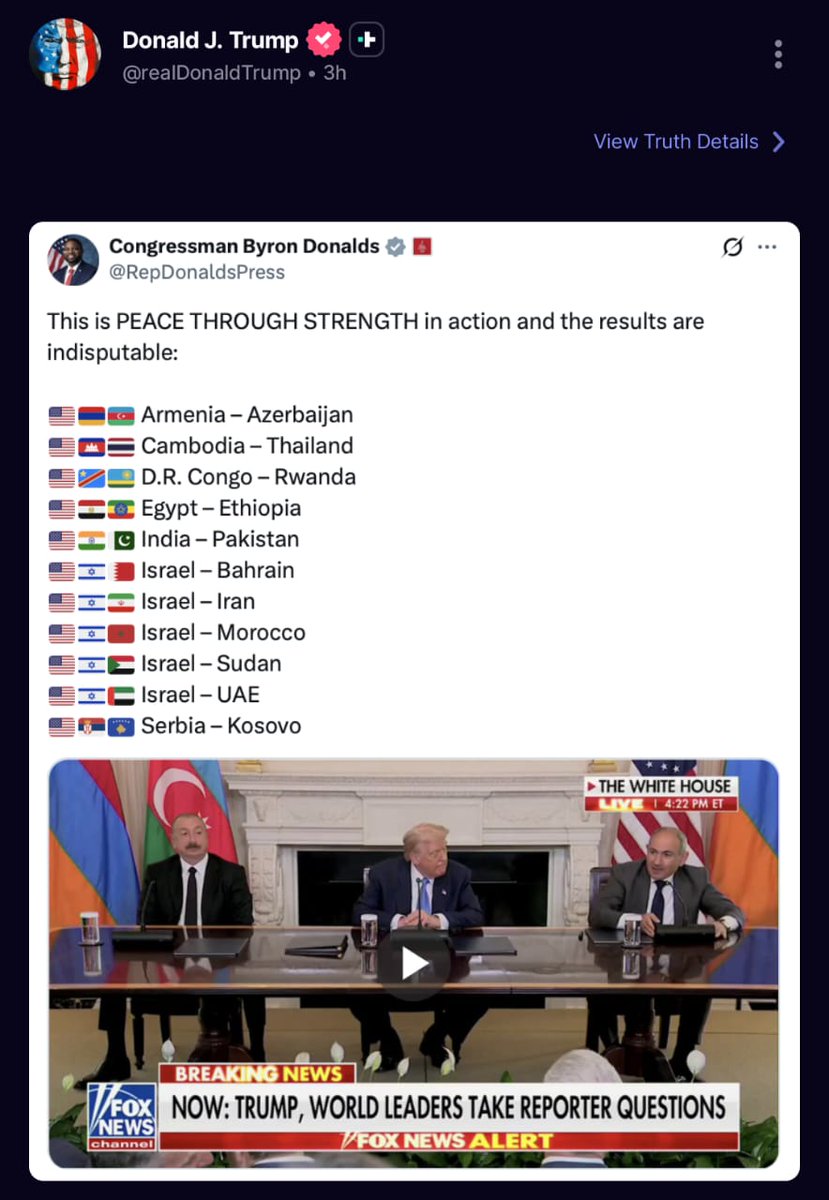
He is not happy:
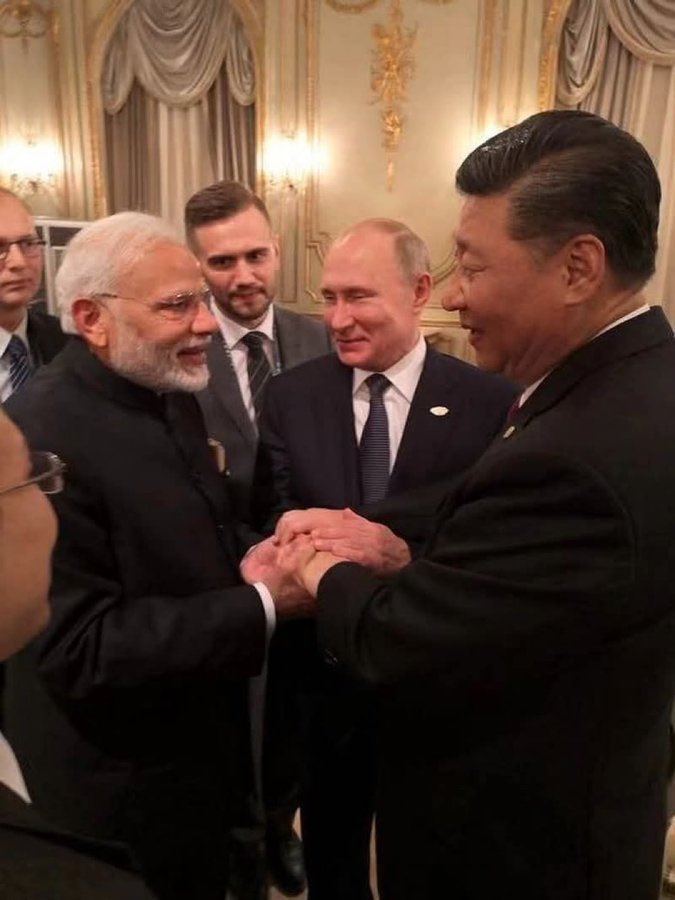
He is mad:
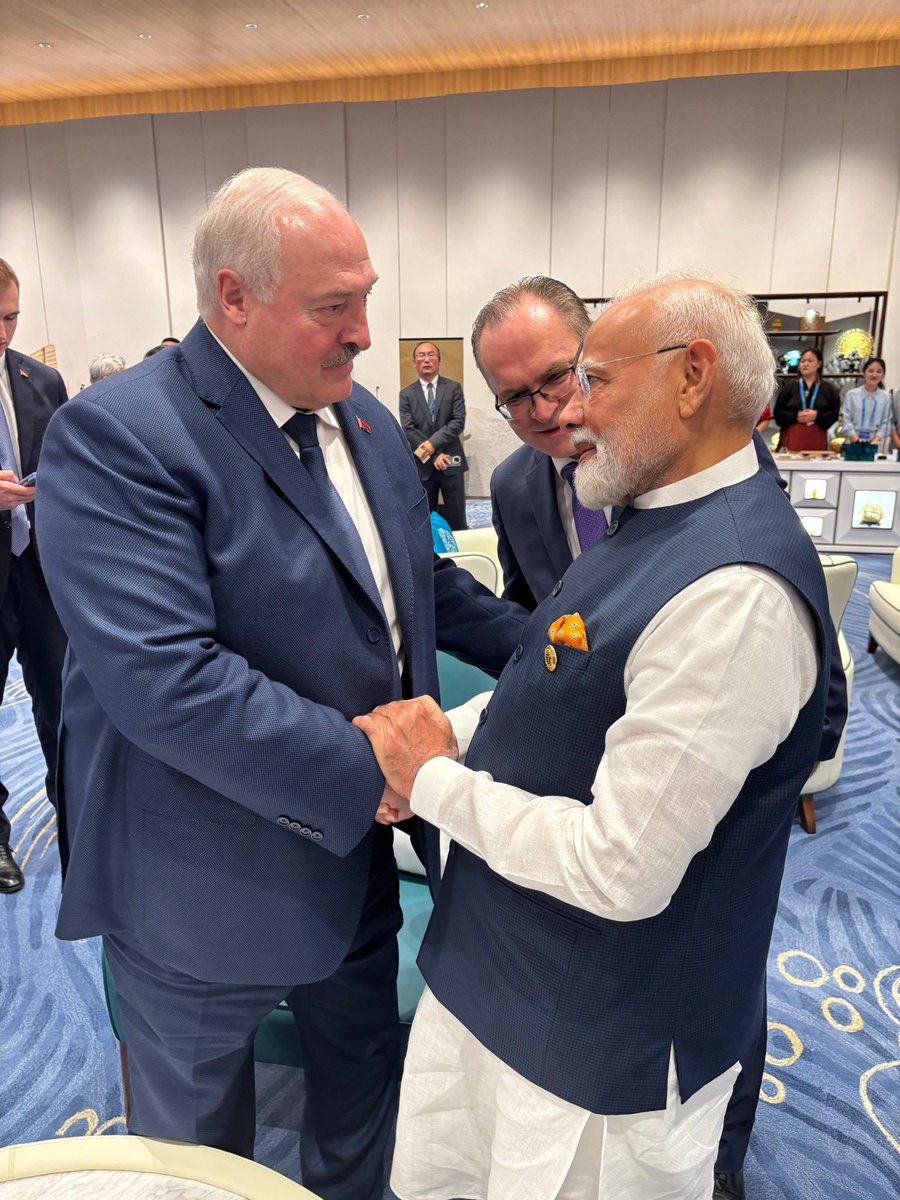

He is not happy:

He is mad:

Consortium of Indian Defence Websites
https://forums.bharat-rakshak.com/



With all due respect, that is all fine. But these techno-legal arguments and terminological exactitude or lack there off childish and ieffective as counter arguments to the realpolitik the US admin is trying to play.KL Dubey wrote: ↑30 Aug 2025 22:35Not really. Most refineries blend several different crudes before refining. It is a complex process. E.g. for diesel the blended crudes are first desalted, then fractionally distilled with crude diesel being one of the fractions, then goes through at least 1 to 3 catalytic reactions to produce diesel of different specification. There are many other intermediate processes not mentioned here. By the end of the process, it is really not possible to say that we are taking oil from russia to supply diesel to pakraine.
These are looking very big. All three images have 'small' variations. Please be kind to server bandwidth usage. Bandwidth costs moneyAmber G. wrote: ↑01 Sep 2025 03:44 Ok: Here is what Trump (re)posted a few hours ago:
[img...]https://pbs.twimg.com/media/Gzs0-cbXsAA ... ike]medium[/strike]small[/img]
He is not happy:
[img...]https://pbs.twimg.com/media/Gzs3WyaawAA ... ke]900x900[/strike]small[/img]
He is mad:
[img...]https://pbs.twimg.com/media/GzslnbsbIAA ... ike]medium[/strike]small[/img]
was not because of
Here's the truth:— the physics was solid, and leaders knew it.
THE TRINITY TEST..scientists at Los Alamos continued privately to have doubts that it would work at all. There was only enough weapons-grade uranium available for one bomb, and confidence in the gun-type design was high..
so I assume you know where I'm going with this
Europe with all it's credibility+ partnerships+economic weight still ended up calling Trump, daddydeterrence is credibility + partnerships + economic weight
@m_saini ji, nice analysis.
As I said earlier, this was my take. I chose my words very carefully — may I suggest you read them again. If you would like further debate or clarification, it may be more appropriate to take it to the nuclear/physics thread, where I have literally hundreds of posts over the past two+ decades dealing with the details of nuclear weapons, tests, and history. (Those threads are still in BRF archives)m_saini wrote: ↑01 Sep 2025 04:06was not because ofHere's the truth:— the physics was solid, and leaders knew it.THE TRINITY TEST..scientists at Los Alamos continued privately to have doubts that it would work at all. There was only enough weapons-grade uranium available for one bomb, and confidence in the gun-type design was high..
Chatgpt etc usually makes such mistakes and it's also easy to miss.
<snip>
“Brahmins profiteering at the expense of the Indian people,” says @RealPNavarro.
Clearly some desi on Team Trump has told him “Sir, the racist shit didn’t really land, let’s try caste.”
Attack Dog-in-Chief’s latest right ahead of Modi-Putin meet.
Look, I know Physics, okay? I've been studying it for, like, over 50 years. Half a century! And I'm not just talking, I've taught it. In the U.S. and India, big places, very important. I learned from the best, people like Bethe and Feynman. Smart guys, believe me. Manhattan Project, you know? I've been to the Trinity site, seen it myself and the U-235 plant, the Oak Ridge. They made the stuff for Hiroshima, folks. I studied Nuclear Physics, the best stuff, with the top professors. I know more about it than anyone.Amber G. wrote: ↑01 Sep 2025 07:48 I have also visited the Trinity test site in person. I have also visited U-235 production site (now open to public) at Oak Ridge (Y-12 & K-25) which supplied U to Hiroshima bomb. I studied Nuclear Physics (in late 60's) at IIT Kanpur and interacted/studied from top Nuclear professors in India.
Yes, the physics is well understood, but this is the problem with theoretical physicists. To bring physics to reality it has to become an engineering problem. I would suggest you interview your Engineering Physics graduates who go on to complete doctoral degrees in ECE, CS, ME, AE, & Material Science.Amber G. wrote: ↑01 Sep 2025 03:06Serious reply - My take (this is what I will say in more serious forums too - and have said similar things before)Mort Walker wrote: ↑01 Sep 2025 01:41
Who said this was for fun? Data and deterrence are needed. IOR is a big area. TSAR bomba concept needs to be re-visited with 100MT. The picture is going to get really clear when Gor goes in for Senate confirmation. Relations are set to go into the toilet once the Sooth-Asian envoy is confirmed.
- The Tsar Bomba fallacy
Revisiting a 100 MT bomb is like bringing back steam engines to prove you can run trains faster. Even in the 1950s, physicists knew that ‘super-megaton’ devices were technically flashy but militarily useless — impossible to deliver, wasteful of fissile material, and creating more fallout than deterrence. Nobody is impressed in 2025 by craters.
- I have personally visited the Nevada Test Site, where the U.S. conducted hundreds of nuclear explosions — including Sedan (1962), a 104 kiloton device that left one of the largest man-made craters on Earth. For years, the U.S. was setting off nearly one test a week. The sheer scale of those experiments proved one point clearly: no nation today needs that kind of destructive “data” anymore. Just as the U.S. moved beyond testing, India too has the technical maturity and scientific base to validate designs without turning deserts into craters. (I wrote about this in nuclear dhaga)
- No ‘data’ gap
We don’t need new mushroom clouds for confidence. As you know Hiroshima’s uranium bomb was never even tested — the physics was solid, and leaders knew it. Nagasaki’s plutonium implosion was tested once, then trusted. Today, with modern supercomputing and decades of open literature, nobody doubts India’s capabilities.
- Deterrence ≠ bigger blast
Credibility doesn’t come from stockpiling giant toys. It comes from precision, delivery systems, and proven competence. India already shows that — from surgical strikes to missile tests that land within meters.
- Reputation through science, not fallout
India’s soft landing on the Moon, its Mars orbiter, and now Operation Sindoor speak louder than a 100 MT crater. Exporting heavy water to Canada or isotopes to the U.S. adds to that credibility — India is seen as a responsible nuclear steward, not a reckless one.
- The real deterrent
In today’s Indo-Pacific, deterrence is credibility + partnerships + economic weight. The quickest way to the ‘toilet’ in relations is to start waving Tsar Bomba fantasies. The quickest way to influence is to lead in space, energy, AI, and precise low-yield deterrence — not in 100 MT fireballs."
Tsar Bomba impressed 1960s schoolboys. In 2025, it only impresses YouTube thumbnails
- Amber G.
So Brahmins instead of doing Veda chanting are becoming Baniyas, tis the varna (capability!) aspect now. Which was the whole point not Castas like the Britshits posited. PNavarro may look idiotic in front of the Britshits now who claimed strict Castas of the portuguese and from their Census determined people of birth belong to Brahmins. Whew. Manu claimed (of manusmriti fame) that all are born Shudra and based on their varna become brahmin, kshatriya, baniya but are firmly rooted in their shudra hood - which is a given since the high command (supreme headquarters) at home orders you to become handyman fixing various things plumbing, lights, cars, all shudra capability. Thanks PNavarro for affirming Manu (now he is your guru!). You sly dog you are on India's side not the Britshit side!“Brahmins profiteering at the expense of the Indian people,” says @RealPNavarro.
This means that the US Deep State has taken over the foreign policy. This is the same shtick that we get from Soros proxies and their princes/vassals in India.Najunamar wrote: ↑01 Sep 2025 08:34 Navarro presuming to lecture on whom to target (Brahmins) shows the US establishment is in very deep doo doo. They are throwing everything possible at Modiji - unfortunately for them, we now have a BC PM, SC/ST President and so no caste shit can stick. White man is truly fcuked…
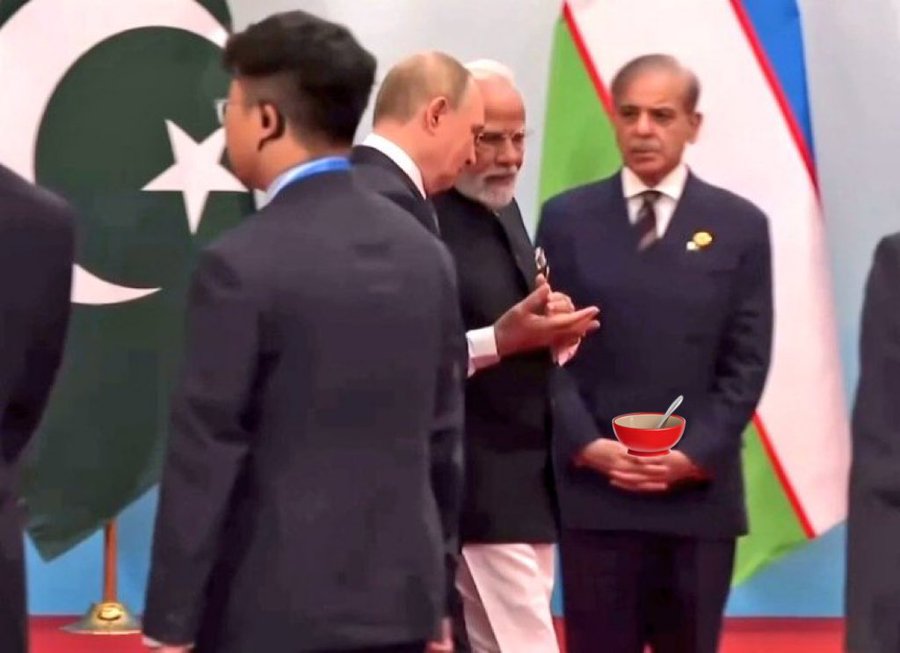
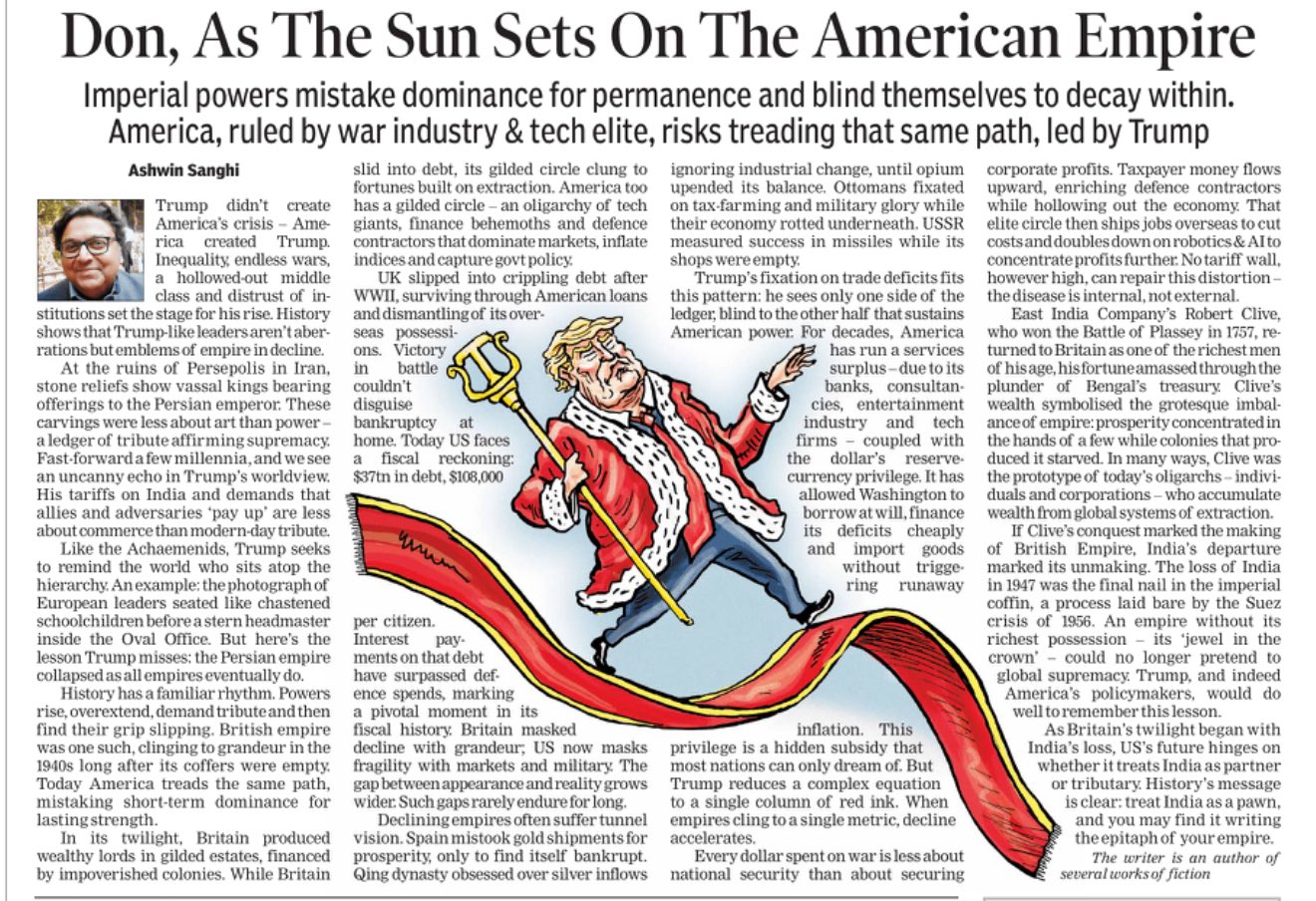
Best explanation I have heard :He claim Brahmins are benefitting from selling Russian oil.
srin wrote: ↑01 Sep 2025 10:18This means that the US Deep State has taken over the foreign policy. This is the same shtick that we get from Soros proxies and their princes/vassals in India.Najunamar wrote: ↑01 Sep 2025 08:34 Navarro presuming to lecture on whom to target (Brahmins) shows the US establishment is in very deep doo doo. They are throwing everything possible at Modiji - unfortunately for them, we now have a BC PM, SC/ST President and so no caste shit can stick. White man is truly fcuked…
"Brahmins profiteering at the expense of the Indian people"
— Peter Navarro, US economist and Trump's counselor for trade.
Clearly, some self-hating Indian in their ranks is guiding them to attack India's fault lines, or they are hand in glove with those trying to gain power in India by fueling caste wars, or both.
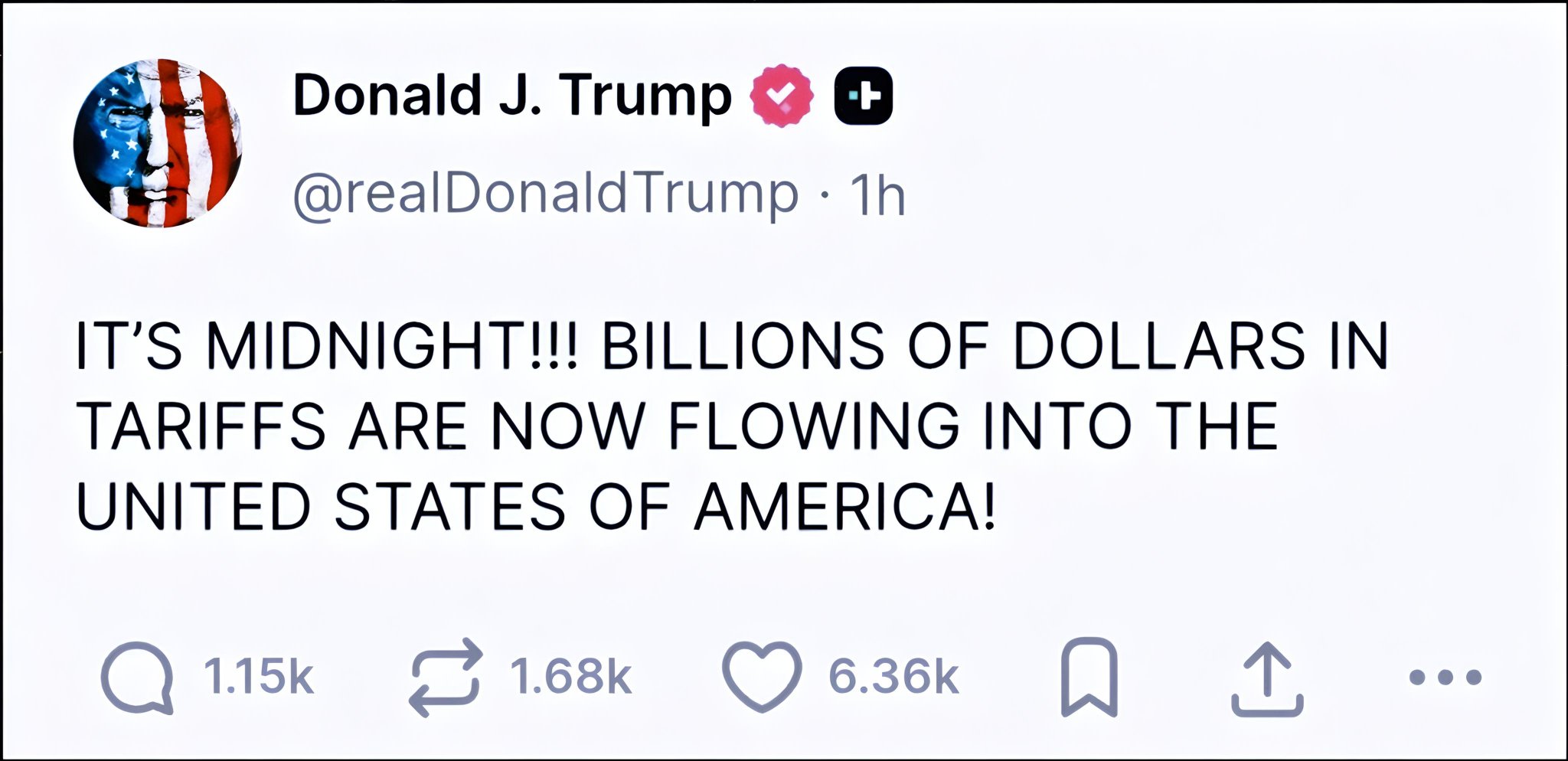
Tariffs are taxes paid by American importers, not foreign govts, meaning the money “flowing in” is actually coming from US businesses and consumers, not China, India or anyone else.
It’s like robbing your own citizens and calling it foreign income.
For someone who claims to be a business genius, not understanding this basic economic principle either points to a dangerously low IQ or deliberate deception, and neither is reassuring.
Yep, It is *obviously* (and clearly known as such) photoshopped.. Actual photo is quite viral and famous by now too.
SCO condemns the Pahalgam terrorist attack in Kashmir which was conspired by Pakistan. SCO asks perpetrators of the terror attack to be brought to justice.
.
India emerges as Ukraine top diesel supplier| Russian Oil|
US hits India over Russian oil, but Ukraine runs on Indian diesel refined from it
According to a Ukrainian oil market analytics firm, India accounted for 15.5% of Ukraine’s diesel imports in July—more than any other country
India has emerged as Ukraine’s top diesel supplier in July 2025, just as the U.S. imposed steep 50% tariffs on Indian goods for continuing Russian oil imports.
The irony is stark: even as Washington punishes India over its energy ties with Moscow, Indian diesel is helping fuel Kyiv’s wartime economy.
According to NaftoRynok, a Ukrainian oil market analytics firm, India accounted for 15.5% of Ukraine’s diesel imports in July—more than any other country. Daily shipments averaged 2,700 tons, making it one of India’s highest monthly fuel export figures for the year.
From January to July 2025, India’s share in Ukraine’s diesel supply rose to 10.2%, a dramatic jump from just 1.9% during the same period in 2024. The diesel reportedly reaches Ukraine via tanker deliveries along the Danube from Romania, and through the OPET terminal in Turkey, despite sanctions.
This comes amid escalating trade tensions between India and the United States. The Trump administration recently imposed 50% tariffs—an initial 25% reciprocal levy, followed by an additional 25%—citing India’s continued imports of discounted Russian crude.
U.S. sanctions target India’s oil sourcing, while Ukrainian battlefields and cities are running on Indian-refined diesel. Much of India’s exported diesel may include reprocessed Russian-origin crude, though official data remains opaque.
Other major suppliers to Ukraine in July included Slovakia (15%), Greece (13.5%), Turkey (12.4%), and Lithuania (11.4%). Indian exports, however, marked the sharpest growth trajectory among them.
Despite American pressure, India has stood firm on energy procurement. It previously complied with U.S. sanctions against Iran and Venezuela, but this time has opted to diversify supplies and prioritise national energy security.
Analysts say the situation underscores the complexity of global energy flows—and the limits of unilateral sanctions in an interconnected market. While Washington targets Moscow’s oil, India’s refiners are quietly becoming critical players in Europe’s energy chain.
New Delhi:
As Prime Minister Narendra Modi exchanged hugs and handshakes with Russian President Vladimir Putin and Chinese premier Xi Jinping at the Shanghai Cooperation Organisation (SCO) summit in China's Tianjin, a key member of US President Donald Trump's team has termed New Delhi-Washington DC ties a "defining relationship of the 21st century".
Marco Rubio, US Secretary of State, has said the relationship between US and India continues to reach new heights.
"This month, we're spotlighting the people, progress, and possibilities driving us forward.
From innovation and entrepreneurship to defense and bilateral ties, it's the enduring friendship between our two peoples that fuels this journey," the US Embassy quoted Rubio as saying.
The post on X came minutes before Prime Minister Modi's meeting with President Putin on sidelines of SCO.
U.S. Embassy India@USAndIndia
The partnership between the United States and India continues to reach new heights — a defining relationship of the 21st century.
This month, we’re spotlighting the people, progress, and possibilities driving us forward.
From innovation and entrepreneurship to defense and bilateral ties, it’s the enduring friendship between our two peoples that fuels this journey.
Follow the hashtag and be a part of #USIndiaFWDforOurPeople. 11:30 AM · Sep 1, 2025
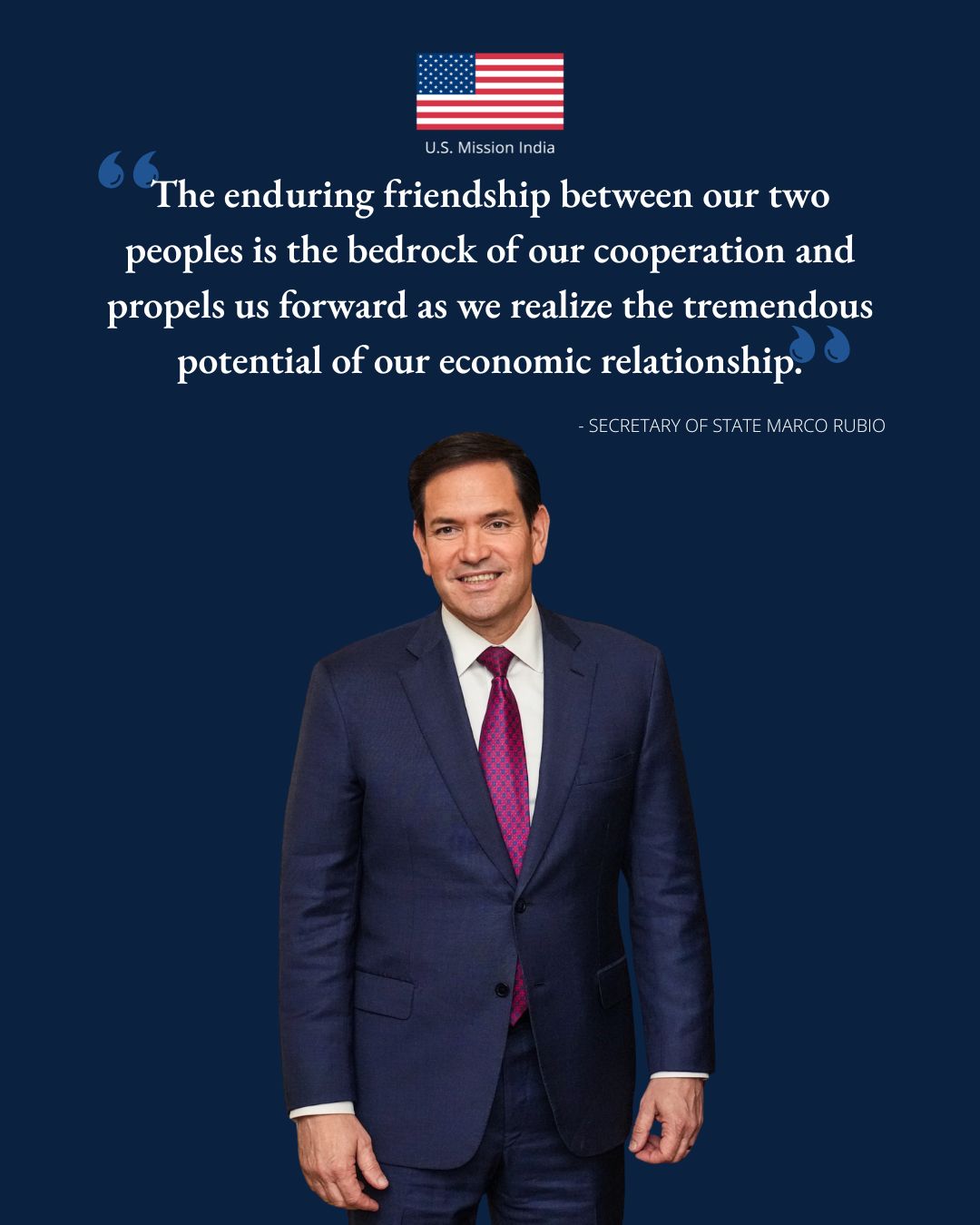
When I traveled to India last February, I found a nation enthralled by America and its newly reelected president. It was a point of national pride that Prime Minister Narendra Modi was the first foreign leader President Donald Trump welcomed to the Oval Office after his inauguration. And in contrast to opinion in Europe and elsewhere, polls showed a majority of Indians had confidence in Trump doing the right thing.
While traveling around the country, I met young people who yearned for the opportunity to study at American universities and build a better future for themselves and their families. Business leaders were on the cusp of expanding exports to the world’s largest consumer market and building a stronger industrial base to compete with China, having been promised a quick trade agreement. Meanwhile, diplomats and military officers believed that mutual animosity toward China would bring the U.S. and India into a new strategic partnership.
For all the optimism about a quick trade deal and stronger bilateral ties, things began to sour quickly after Modi’s return from Washington. In late February, Indians watched as their fellow countrymen were deported by the U.S. Then, amonth later, Trump announced his “Liberation Day” tariffs — socking India with a 26 percent duty on all imports into the U.S.
But the biggest blow to the relationship came in May, after India retaliated against Pakistan for a terrorist attack that killed 26 tourists in Indian-controlled Kashmir. The fighting between the two countries escalated quickly, and by the third day, India was targeting a military base near the army division that oversees Pakistan’s nuclear arsenal.
Trump immediately claimed credit for engineering the end to fighting, suggesting he used trade to bring both parties to heel. “We stopped a nuclear conflict,” the U.S. leader claimed. “I think it could have been a bad nuclear war, millions of people could have been killed, so I’m very proud of that.” But while Pakistan was quick to give the White House the credit it wanted, India insisted the deal had been reached bilaterally.
Eventually, as trade talks between India and the U.S. continued to stall over agriculture and other issues, Trump and Modi spoke on the phone in June. I have been told that during this call, the U.S. president insisted Modi publicly give him credit for ending the fighting in May, and that he invited the Indian prime minister to the White House when the Chief of Army Staff of Pakistan Asim Munir would also be visiting.
Modi wasn’t about to consider either of these requests. India has always insisted its conflict with Pakistan is a purely bilateral issue, pointing to earlier agreements between the two countries that reject outside mediation. And as prime minister, Modi could never accept the idea of meeting with the Pakistani military chief as if they were equals.
This was the last call between the two leaders. Washington’s stance in the trade negotiations hardened after Modi’s rejection of Trump’s entreaties, making a deal less likely. And Trump has been insisting that a final agreement be reached between him and Modi directly. However, the Indian leader knows what the U.S. president really wants — his public assent to the idea that Trump prevented a nuclear confrontation.
This background helps partly explain why Trump decided to single India out for punishment for its purchase of Russian oil not long after.
It was a confusing decision: The U.S. has long encouraged India to buy Russian oil, provided its purchases stay below the $60 oil cap agreed by Western countries. Without Russian supplies, oil prices would spike and fuel inflation. Plus, China is a far bigger buyer of oil and gas than India, yet no tariffs or sanctions were imposed on Beijing.
So, after a quarter century of building a strategic partnership with the world’s most populous economy — its second-largest democracy and soon-to-be third-largest economy — why single India out? As commentators around the world were quick to note, it makes no economic, political or strategic sense.
But the damage has already been done. The enrollment of Indian students in U.S. universities is down 40 to 50 percent from last year’s record high of 300,000. Businesses are looking for other export markets, aided by new trade deals with Britain and, soon, the EU. Indian officials are strengthening relations with Moscow, and Modi traveled to China for the first time in seven years.
Those in India who long warned about entangling alignments are now having a field day, and Modi himself is talking about the critical importance of self-reliance. The U.S., meanwhile, is losing a strategic partner in an important part of the world.
Bessent secured an internship with Jim Rogers after meeting him at a Yale Career Center event.[19] After graduation, Bessent worked at Brown Brothers Harriman and then for Jim Chanos at Kynikos Associates. He joined Soros Fund Management (SFM) in 1991, eventually becoming head of the London office. In 1992, Bessent was a leading member of the team whose bet on the Black Wednesday collapse of the British Pound sterling earned the firm over $1 billion.[8][20][21][22] Some sources, such as Forbes, describe Bessent as having been a "protégé" of George Soros, SFM's founder.[23][24]
After resigning from SFM in 2000, Bessent founded a $1 billion hedge fund, Bessent Capital.[8][25] The fund closed in 2005. Bessent has said he learned that he should not change his style or the firm's approach because of investor preferences.[26] He was also a senior investment adviser to fund-of-funds Protégé Partners.[27][20] Bessent returned to SFM as chief investment officer from 2011 to 2015.[21] His bet against the Japanese yen in 2013 yielded more than $1.2 billion in profit in three months.[28]
From 2006 to 2011, Bessent was an adjunct professor of economic history at Yale, where he taught three courses.[26][20]
Key Square Group
Bessent left SFM in 2015 to launch Key Square Group, a hedge fund named after a spot on the chessboard, with Michael Germino, who had been the global head of capital markets at SFM. It received a $2 billion anchor investment from George Soros.[22][29][30][31][32] Key Square uses geopolitics and economics to make macro investments.[11][33] Its main fund returned 13% in 2016 but declined or broke even every year from 2017 to 2021 before making major gains in 2021, 2022 and 2023. The inconsistent track record scared away clients. Assets under management shrank from $5.1 billion in 2017[33][34] to $577 million in 2023 and the number of institutional investors declined from 180 to 20 over the same period. It earned "double digits" percentagewise in 2024.[35]
As part of a prearranged deal, in 2018 the firm returned Soros's investment as it took in other assets.[33] Its investors include Australia's sovereign wealth fund, Future Fund.[34]
Bessent announced that he would sever ties with the group as Treasury Secretary.
https://x.com/wartrophy_414/status/1962514470300995622Bharadwaj wrote: ↑01 Sep 2025 19:17 https://pbs.twimg.com/media/Gzw843KbAAA ... name=small
https://x.com/ShivAroor/status/1962510493941452816
Taco Time
While people like Navarro have very little idea of what they are talking about, we shouldn't fixate too much on the "brahmin" appellation. In USA "brahmin" is often used to denote "elite" in general, and not the actual caste/jati/varna that is meant in Bharat. For example, there is a luxury/high-end handbag brand named Brahmin. The same is true of the word "pundit" in western lingo, which does not mean the traditional definition of a pandit in Bharat.